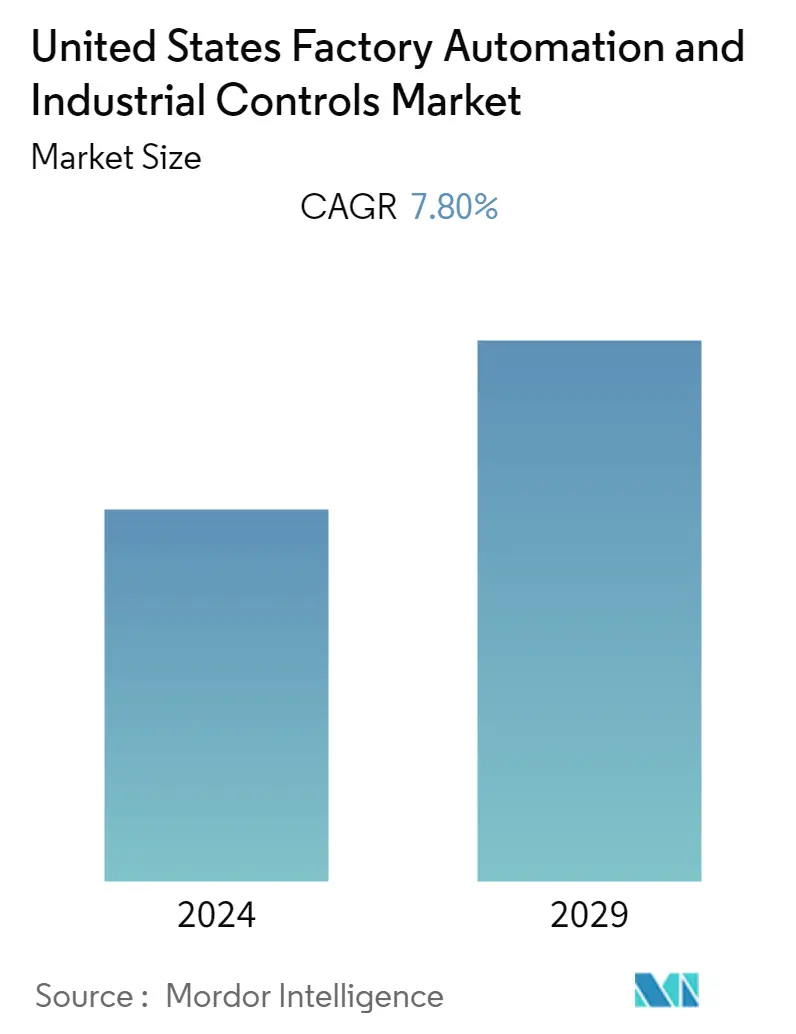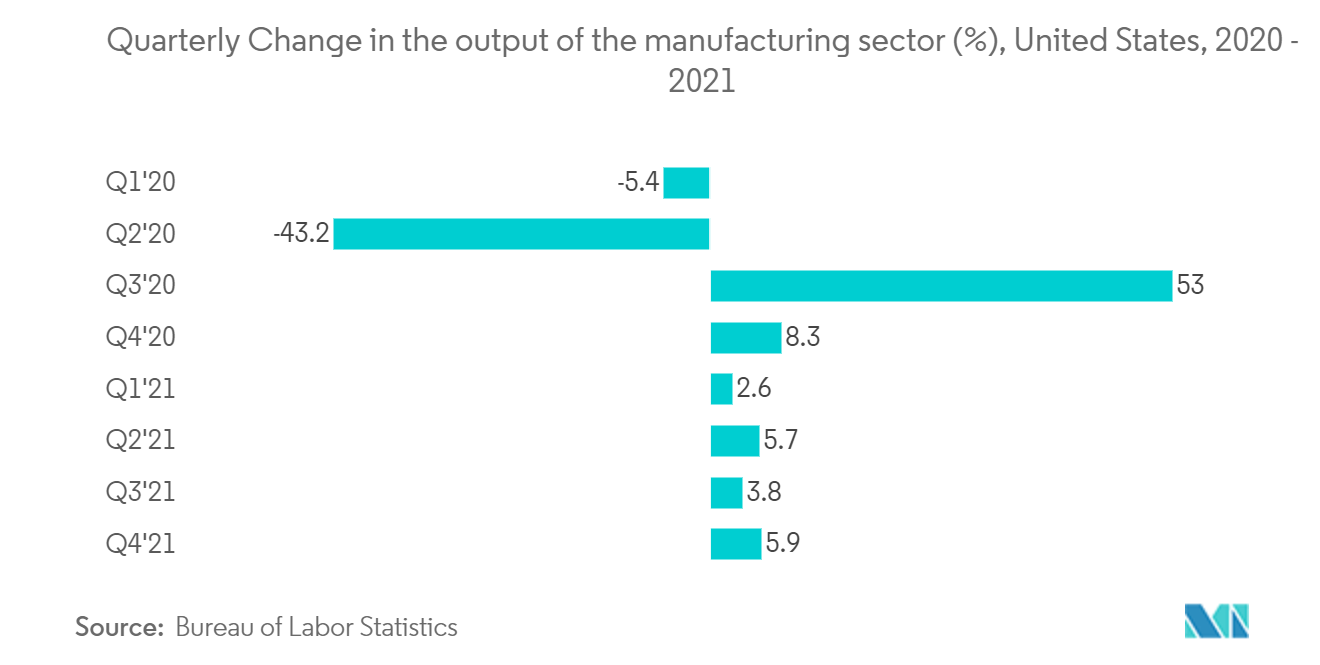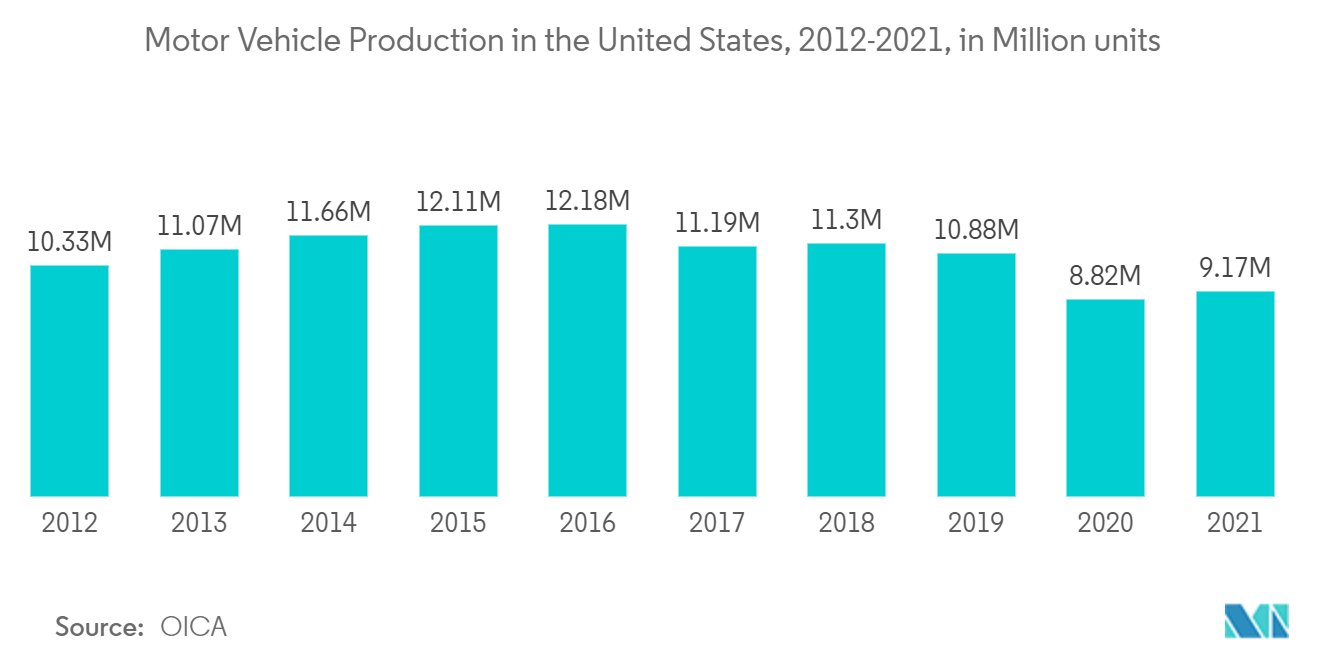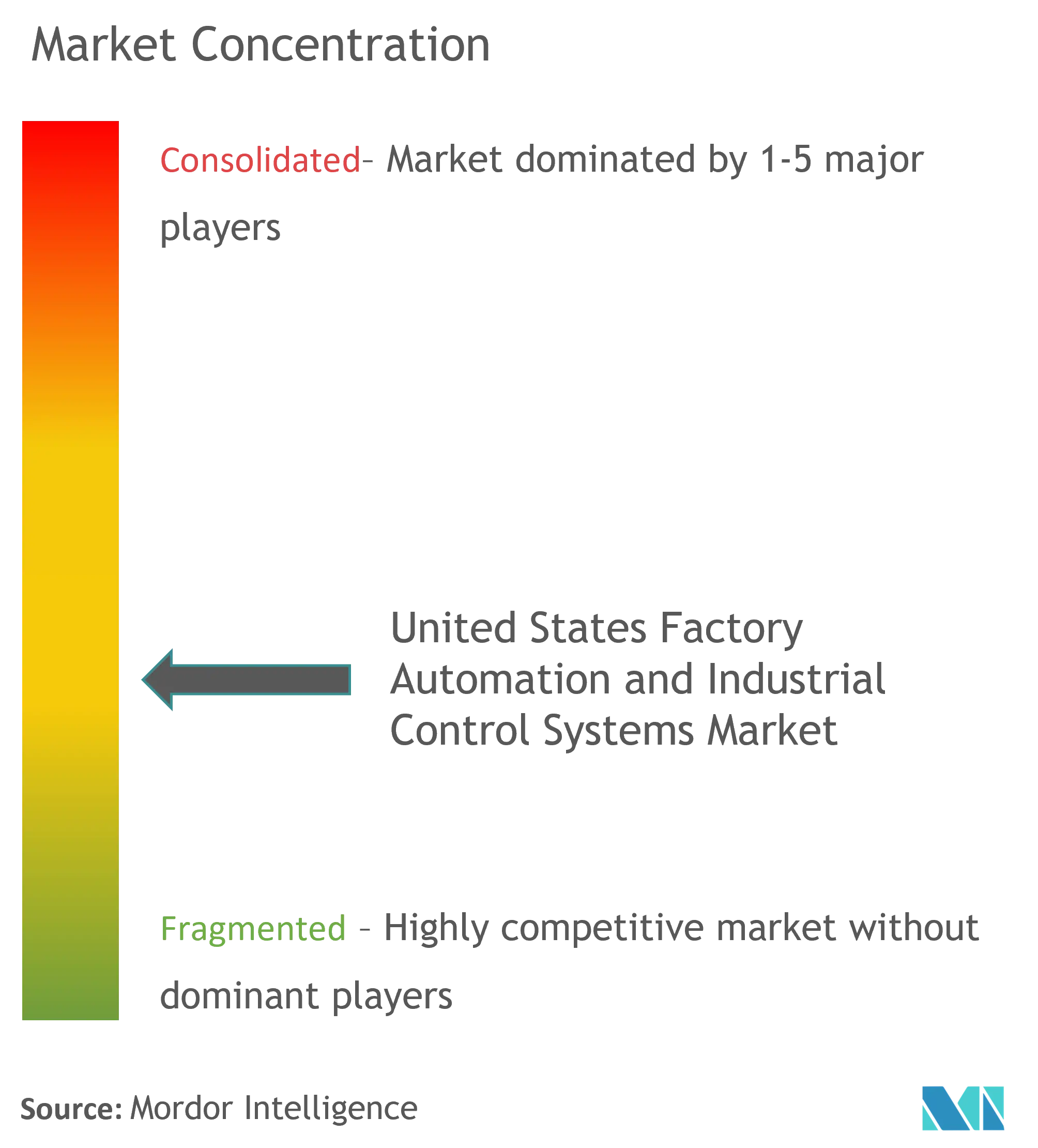US Factory Automation and Industrial Controls Market Size

| Study Period | 2019 - 2029 |
| Base Year For Estimation | 2023 |
| Forecast Data Period | 2024 - 2029 |
| Historical Data Period | 2019 - 2022 |
| CAGR | 7.80 % |
| Market Concentration | Medium |
Major Players
*Disclaimer: Major Players sorted in no particular order |
US Factory Automation and Industrial Controls Market Analysis
The United States factory automation and industrial controls market is expected to register a CAGR of 7.8% during the forecast period. Due to the impact of the COVID-19 pandemic, robots are projected to play a major role in bringing jobs back to the United States, improving factory productivity, and helping manufacturers adapt to changing preferences of the consumer.
- Factory automation and control solutions facilitate the automation of an entire manufacturing/production facility by designing and constructing a fully integrated and intelligent control system, including sensors, robots, computers, industrial instruments, and advanced data processing solutions.
- These solutions are implemented primarily to reduce companies' reliance on unreliable and error-prone manual processes and replace them with command-response activities executed by logical programming commands and mechanized equipment. Some general-purpose industrial-process controllers include programmable logic controllers (PLCs) and stand-alone I/O modules.
- A notable impact of COVID-19 was observed in the US industrial sector. Due to several restrictions on staffing in industries, the growth of the industrial sector was negatively impacted. According to the Bureau of Economic Analysis (BEA) data, the country's real GDP decreased at an annual rate of 4.8% in the first quarter of 2020. However, the pandemic significantly enhanced awareness about using advanced technologies such as automation, AI, IIoT, etc. These are expected to have a long-term impact on the growth of the market studied in the United States.
- In recent years, especially after the pandemic, the US government started focusing on boosting its local manufacturing industries with initiatives like "Make in America," which is expected to drive the growth of the market studied. For instance, in March 2022, the US government announced that for the products to qualify as Made in America for federal procurement, 60% of the value of their parts should be manufactured in the country, which earlier accounted for 55%. The government plans to enhance it further to 65% in 2024 and 75% in 2029.
US Factory Automation and Industrial Controls Market Trends
This section covers the major market trends shaping the US Factory Automation & Industrial Controls Market according to our research experts:
Distributed Control Systems (DCS) are Expected to Witness Significant Adoption
- DCS are process-oriented platforms that depend on a network of interconnected sensors, controllers, terminals, and actuators to act as a centralized master controller for all of a facility's production operations. Thus, a DCS focuses on controlling and monitoring processes and allowing facility operators to see all facility operations in one place.
- DCS allows the implementation of more advanced process automation strategies because it operates on a closed-loop control platform. This makes DCS ideal for controlling operations at a single facility or factory. Additionally, a DCS is critical for maximizing the visibility of a facility's day-to-day operational processes.
- One of the significant benefits of DCS systems is that the digital communication between distributed controllers, workstations, and other computing elements follows the peer-to-peer access principle. To achieve greater precision and control in process industries, like the petrochemical, nuclear, and oil and gas industries, there is an increasing demand for controllers which offer specified process tolerance around an identified set point.
- These requirements have driven the adoption of DCS, as these systems provide lower operational complexity, project risk, and functionalities, like flexibility for agile manufacturing in highly-demanding applications. The ability of DCS to integrate PLCs, turbomachinery controls, safety systems, third-party controls, and various other plant process controls for heat exchangers, feedwater heaters, and water quality, among others, further drives the adoption of DCS in the energy sector.
- Considering the growing concern regarding cybersecurity issues with industrial control systems such as DCS, several organizations and DCS providers are taking initiatives to make distributed control systems more secure.

Automotive Industry is Expected to Exhibit Significant Adoption
- The automotive industry is one of the prominent sectors that hold a significant in worldwide automated manufacturing facilities. It is observed that the production facilities of various automakers are automated to maintain accuracy and efficiency. Further, the growing trend of replacing conventional vehicles with EVs is expected to further augment the automotive industry's demand.
- One of the primary concerns of the automotive industry is the duration of a project. Quick return-on-investment projects, along with low-cost automation and cost innovation, help the manufacturers to improve competitiveness through efficiency improvement.
- Moreover, the growing adoption of automation in manufacturing processes and digitization and AI involvement are primary factors driving industrial robots in the automotive sector. It has been identified that auto assembly increased significantly, using automation, showing a growth pattern in the number of cars being produced worldwide while simultaneously cutting costs, paving the way for the growth of smart factory implementation in this sector.
- The United States is among the most promising markets for vendors offering smart factory solutions, owing to its presence in some of the biggest industries. The country is fast adopting advanced industrial technologies, where data is being used on a large scale for production while integrating the data with various manufacturing systems throughout the supply chain. The market studied is expected to receive significant growth opportunities during the forecast period.
- The US automotive industry is among the largest globally and is home to some of the biggest auto manufacturers, such as General Motors, Ford, Chrysler, etc. According to OICA, in 2021, about 9.17 million motor vehicles were manufactured in the United States, compared to 8.82 million in 2020. The country offers a huge opportunity as the automotive sector accounts for the significant adoption of automation technologies to enhance production efficiency.

US Factory Automation and Industrial Controls Industry Overview
The United States factory automation and industrial controls market is competitive due to several players in the market. Players are involved in product development and strategic activities such as partnerships, mergers, and acquisitions. Some of the key developments in the market are:
- April 2021 - Google Cloud and Siemens collaborated to streamline production operations and boost shop floor efficiency. Siemens plans to integrate Google Cloud's top data cloud and artificial intelligence/machine learning (AI/ML) capabilities with its factory automation solutions to assist manufacturers in the manufacturing process.
US Factory Automation and Industrial Controls Market Leaders
-
Rockwell Automation Inc.
-
Honeywell International Inc.
-
ABB Ltd
-
Schneider Electric SE
-
Emerson Electric Company
*Disclaimer: Major Players sorted in no particular order

US Factory Automation and Industrial Controls Market News
- April 2022 - Critical Manufacturing unveiled the latest version of its Manufacturing Execution System (MES) at Hannover Messe 2022. Advancements in Critical Manufacturing MES (V9) help high-tech manufacturers prevail amidst changing market conditions.
- September 2021 - Rockwell Automation, Inc., the digital transformation and industrial automation company completed the Plex Systems acquisition. This acquisition could allow Rockwell to strengthen their cloud-delivered intelligent manufacturing solutions and provide smart manufacturing in customer operations.
US Factory Automation and Industrial Controls Market Report - Table of Contents
1. INTRODUCTION
- 1.1 Study Assumptions and Market Definition
- 1.2 Scope of the Study
2. RESEARCH METHODOLOGY
3. EXECUTIVE SUMMARY
4. MARKET INSIGHTS
- 4.1 Market Overview
- 4.2 Industry Value Chain Analysis
-
4.3 Industry Attractiveness - Porter's Five Forces Analysis
- 4.3.1 Bargaining Power of Suppliers
- 4.3.2 Bargaining Power of Consumers
- 4.3.3 Threat of New Entrants
- 4.3.4 Threat of Substitutes
- 4.3.5 Intensity of Competitive Rivalry
- 4.4 Assessment of COVID -19 impact on the Industry
5. MARKET DYNAMICS
-
5.1 Market Drivers
- 5.1.1 Gaining Prominence for Automation Technologies
- 5.1.2 Proactive Government Policies and a Vibrant Startup Ecosystem
-
5.2 Market Challenges
- 5.2.1 Trade Tensions and Monetary Policy Tightening
- 5.3 Industry Policies and Regulations
- 5.4 Key Case Studies and Implementation Scenarios
6. MARKET SEGMENTATION
-
6.1 By Type
- 6.1.1 Industrial Control Systems
- 6.1.1.1 Distributed Control System (DCS)
- 6.1.1.2 Programable Logic Controller (PLC)
- 6.1.1.3 Supervisory Control and Data Acquisition (SCADA)
- 6.1.1.4 Product Lifecycle Management (PLM)
- 6.1.1.5 Manufacturing Execution System (MES)
- 6.1.1.6 Human Machine Interface (HMI)
- 6.1.1.7 Other Industrial Control Systems
- 6.1.2 Field Devices
- 6.1.2.1 Machine Vision
- 6.1.2.2 Industrial Robotics
- 6.1.2.3 Motors and Drives
- 6.1.2.4 Safety Systems
- 6.1.2.5 Sensors & Transmitters
- 6.1.2.6 Other Field Devices
-
6.2 By End-user Industry
- 6.2.1 Oil and Gas
- 6.2.2 Chemical and Petrochemical
- 6.2.3 Power and Utilities
- 6.2.4 Food and Beverage
- 6.2.5 Automotive and Transportation
- 6.2.6 Pharmaceutical
- 6.2.7 Other End-user Industries
7. COMPETITIVE LANDSCAPE
-
7.1 Company Profiles
- 7.1.1 Schneider Electric SE
- 7.1.2 Rockwell Automation Inc.
- 7.1.3 Honeywell International Inc.
- 7.1.4 Emerson Electric Company
- 7.1.5 ABB Ltd
- 7.1.6 Mitsubishi Electric Corporation
- 7.1.7 Siemens AG
- 7.1.8 Omron Corporation
- 7.1.9 Yokogawa Electric Corporation
- 7.1.10 Fanuc Corporation
- *List Not Exhaustive
8. INVESTMENT ANALYSIS
9. FUTURE OUTLOOK
** Subject To AvailablityUS Factory Automation and Industrial Controls Industry Segmentation
The study characterizes the market based on the type of products, such as DCS, PLC, SCADA, motors and Drives, robotics, and among others. By the end-user industry, the market is divided into oil and gas, chemical and petrochemical, power, and food and beverage, among others. The scope of the study is currently focused on the United States. The market sizes and forecasts are provided in terms of value (USD million) for all the above segments.
| By Type | Industrial Control Systems | Distributed Control System (DCS) |
| Programable Logic Controller (PLC) | ||
| Supervisory Control and Data Acquisition (SCADA) | ||
| Product Lifecycle Management (PLM) | ||
| Manufacturing Execution System (MES) | ||
| Human Machine Interface (HMI) | ||
| Other Industrial Control Systems | ||
| By Type | Field Devices | Machine Vision |
| Industrial Robotics | ||
| Motors and Drives | ||
| Safety Systems | ||
| Sensors & Transmitters | ||
| Other Field Devices | ||
| By End-user Industry | Oil and Gas | |
| Chemical and Petrochemical | ||
| Power and Utilities | ||
| Food and Beverage | ||
| Automotive and Transportation | ||
| Pharmaceutical | ||
| Other End-user Industries |
US Factory Automation and Industrial Controls Market Research FAQs
What is the current United States Factory Automation and Industrial Controls Market size?
The United States Factory Automation and Industrial Controls Market is projected to register a CAGR of 7.80% during the forecast period (2024-2029)
Who are the key players in United States Factory Automation and Industrial Controls Market?
Rockwell Automation Inc., Honeywell International Inc., ABB Ltd, Schneider Electric SE and Emerson Electric Company are the major companies operating in the United States Factory Automation and Industrial Controls Market.
What years does this United States Factory Automation and Industrial Controls Market cover?
The report covers the United States Factory Automation and Industrial Controls Market historical market size for years: 2019, 2020, 2021, 2022 and 2023. The report also forecasts the United States Factory Automation and Industrial Controls Market size for years: 2024, 2025, 2026, 2027, 2028 and 2029.
U.S. Factory Automation & Industrial Controls Industry Report
Statistics for the 2024 U.S. Factory Automation & Industrial Controls market share, size and revenue growth rate, created by Mordor Intelligence™ Industry Reports. U.S. Factory Automation & Industrial Controls analysis includes a market forecast outlook to 2029 and historical overview. Get a sample of this industry analysis as a free report PDF download.



